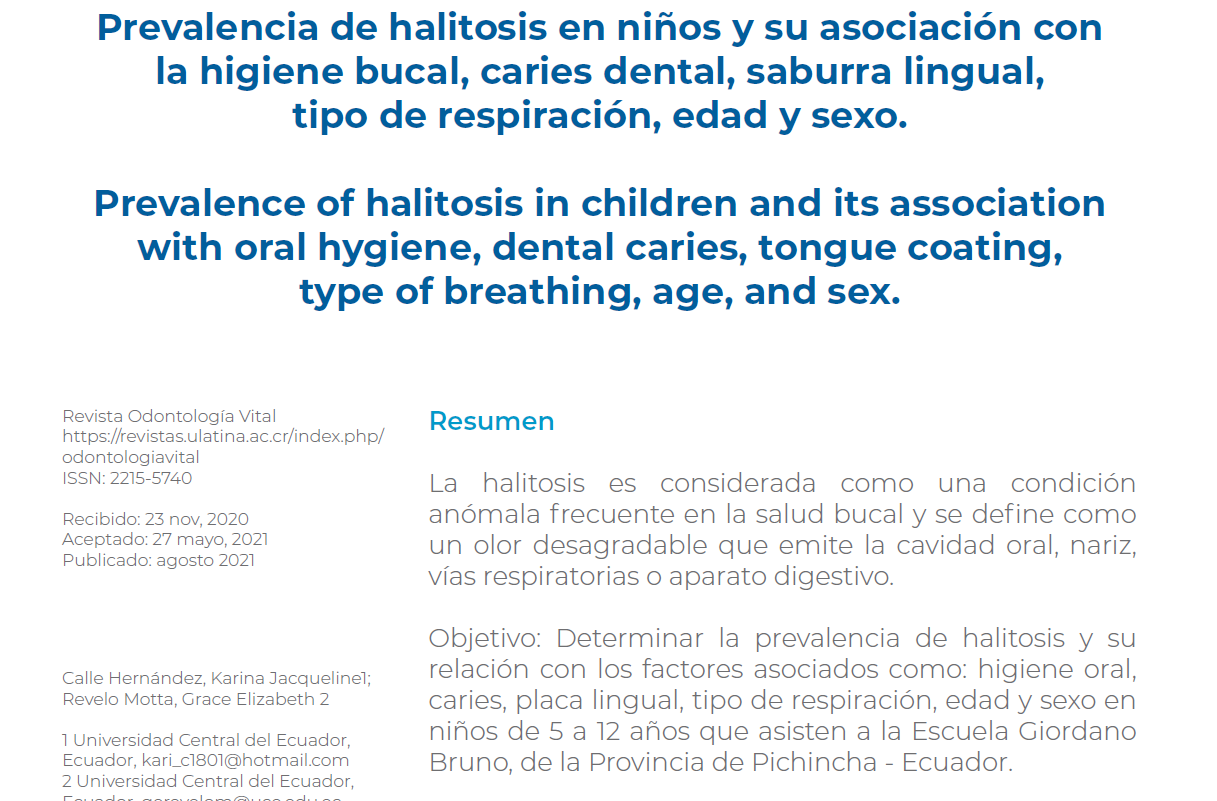Prevalence of halitosis and associated factors in children aged 5 to 12 years in a school in Quito, Ecuador
DOI:
https://doi.org/10.59334/ROV.v2i35.408Keywords:
Halitosis, Oral hygiene, Tongue coating, Dental CariesAbstract
Introduction: Halitosis is considered a very common abnormal condition in oral health, which is defined as an unpleasant odor emitted by the oral cavity, nose, respiratory tract or digestive system.
Objective: To determine the prevalence of halitosis and its relationship with associated factors such as oral hygiene, caries, tongue plaque, type of breathing, age and sex in children aged 5 to 12 years who attend the Giordano Bruno School in the Province of Pichincha - Ecuador.
Materials and methods: Observational, descriptive, cross-sectional study carried out in a population of 178 students aged 5 to 12 years. The sample consisted of 122 children selected through probabilistic sampling. Informed consent was requested to participate in the study. The prevalence of halitosis was assessed with the volatile sulfur compound detector monitor and associated factors were measured by means of the IHOS, the Winkel coated tongue index, the mouth mirror test and the ceo-d and CPO-D index. The data were analyzed using the Chi-square test with a significance value of 0.05 and a Binary Logistic Regression analysis.
Results: In the Pearson Chi-square test there is a relationship between halitosis and tongue coating, oral hygiene, age and sex that is statistically significant (< 0.05), there was no relationship between halitosis and the type of breathing and the presence of caries. When performing the binary logistic regression it was found that children with tongue coating have 177 times greater risk of presenting halitosis while children with regular oral hygiene have 205 times greater risk of presenting halitosis.
Conclusion: The prevalence of halitosis was 50% and was related to oral hygiene, tongue coating, age and sex.
Downloads
References
Arellano Aguilar, G., Flores Hernández, P. S., López Pelcastre, D. K., & Domínguez Carrillo, L. G. (2018). Halitosis persistente en adolescente. Acta Médica Grupo Ángeles, 16(3), 236–241.
Bonilla, G. (2016). Indice de placa bacteriana visible (pp. 1–3). ESE Carmen Emilia Ospina. http://www.esecarmenemiliaospina.gov.co/2015/images/calidad/mapa3/4ServiciosAmbulatorios/2Subprocesos/2Odontologia/4DocumentosdeApoyo/SA-S2D20-V1Indice_Placa_Bacteriana.pdf
Cabrera, J. A. M., López, A. L. S. M., Vásquez, M. J. G., Rocha, A. G., García, L. V. M., & Quiroz, E. H. (2019). Prevalencia de halitosis oral en alumnos de nuevo ingreso de la Facultad de Odontología de la Universidad Veracruzana en Poza Rica, Veracruz. Revista Mexicana De Medicina Forense Y Ciencias De La Salud, 4(1sup), 51–53.
Çoban, Z., & Sönmez, I. (2017). Halitosis: a review of current literature. Meandros Med Dent J, 18, 164–170. https://doi.org/10.4274/meandros.68077
De Matos, G., J, dos S., Guedes-Granzotti, R., da Silva, K., Baldrighi, S., & César, C. (2017). A prevalência de hábitos orais em pré-escolares La prevalencia de hábitos orales. Distúrb Comu, 29(1), 68–76. https://doi.org/10.23925/2176-2724.2017v29i1p68-76
Guedes, C. C., Bussadori, S. K., Weber, R., Motta, L. J., Costa Da Mota, A. C., & Amancio, O. M. S. (2019). Halitosis: Prevalence and association with oral etiological factors in children and adolescents. Journal of Breath Research, 13(2). https://doi.org/10.1088/1752-7163/aafc6f
Infante, C., Rosas, L., & Benavides, B. (2015). Manual de Ortopedia Maxilar: modelo diagnóstico de maloclusiones para pacientes en crecimiento. Universidad Nacional de Colombia.
Lundgren, T., Mobilia, A., Hallström, H., & Egelberg, J. (2007). Evaluation of tongue coating indices. Oral Diseases, 13(2), 177–180. https://doi.org/10.1111/j.1601-0825.2006.01261.x
Motta, L. J., Bachiega, J. C., Guedes, C. C., Laranja, L. T., & Bussadori, S. K. (2011). Association between halitosis and mouth breathing in children. Clinics, 66(6), 939–942. https://doi.org/10.1590/S1807-59322011000600003
Patil, P. S., Pujar, P., Poornima, S., & Subbareddy, V. V. (2014). Prevalence of oral malodour and its relationship with oral parameters in Indian children aged 7-15 years. European Archives of Paediatric Dentistry, 15(4), 251–258. https://doi.org/10.1007/s40368-014-0109-0
Piovano, S., Squassi, A., & Bordoni, N. E. (2010). Estado del arte de indicadores para la medición de caries dental. Revista de La Facultad de Odontología (UBA), 25(58), 29–43.
Sayedi, S. J., Modaresi, M. R., & Saneian, H. (2015). Effect of metronidazole on halitosis of 2 to 10 years old children. Iranian Journal of Pediatrics, 25(1), 15–17. https://doi.org/10.5812/ijp.252
Tanita Corporation. (2010). Instruction Manual BreathChecker (p. 1). http://www.tanita.com
Ueno, M., Ohnuki, M., Zaitsu, T., Takehara, S., Furukawa, S., & Kawaguchi, Y. (2018). Prevalence and risk factors of halitosis in Japanese school children. Pediatrics International, 60(6), 588–592. https://doi.org/10.1111/ped.13561
Uvidia, L., & Revelo, G. (2016). Predominio de halitosis según el género, en niños y jóvenes de 6 a 17 años en el proyecto “Niños con esperanza” [Universidad Central del Ecuador]. http://www.dspace.uce.edu.ec/handle/25000/9193
Villa, A., Zollanvari, A., Alterovitz, G., Cagetti, M., Strohmenger, L., & Abati, S. (2014). Prevalence of halitosis in children considering oral hygiene, gender and age. International Journal of Dental Hygiene, 12(3), 208–212. https://doi.org/10.1111/idh.12077
Winkel, E. G., Roldán, S., Van Winkelhoff, A. J., Herrera, D., & Sanz, M. (2003). Clinical effects of a new mouthrinse containing chlorhexidine, cetylpyridinium chloride and zinc-lactate on oral halitosis: A dual-center, double-blind placebo-controlled study.Journal of Clinical Periodontology, 30(4), 300–306. https://doi.org/10.1034/j.1600-051X.2003.00342.x

Downloads
Published
License
Copyright (c) 2021 Grace Revelo, Karina Jacqueline Calle Hernández

This work is licensed under a Creative Commons Attribution 4.0 International License.
Authors who publish with Odontología Vital agree to the following terms:
- Authors retain the copyright and grant Universidad Latina de Costa Rica the right of first publication, with the work simultaneously licensed under a Creative Commons Attribution 4.0 International license (CC BY 4.0) that allows others to share the work with an acknowledgement of the work's authorship and initial publication in this journal.
- Authors are able to enter into separate, additional contractual arrangements for the non-exclusive distribution of the Odontología Vital's published version of the work (e.g., post it to an institutional repository or publish it in a book), with an acknowledgement of its initial publication.
- Authors are permitted and encouraged to post their work online (e.g., in institutional repositories or on their website) prior to and during the submission process, as it can lead to productive exchanges, as well as earlier and greater citation of published work.






